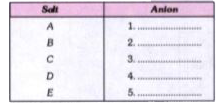The preservation of meat by salting and of fruits by adding sugar protects them from bacterial action because
bacteria die of eating sugar or salt
due to osmosis bacteria lose water on salted meat or candid fruit and die
due to osmosis bacteria gain water on salted meat or candid fruit and die
bacteria get stuck to the salt and sugar layers and die
The correct Answer is:B
The bacteria on salted meat or candid fruit loss water through osmosis, shrink and die
Topper's Solved these Questions
- SOLUTIONS BOOK - NCERT FINGERTPS ENGLISHCHAPTER - SOLUTIONS EXERCISE - HOTS
10 Videos
- SOLUTIONS BOOK - NCERT FINGERTPS ENGLISHCHAPTER - SOLUTIONS EXERCISE - EXEMPLAR PROBLEMS
24 Videos
- PRACTICE PAPER -3BOOK - NCERT FINGERTPS ENGLISHCHAPTER - PRACTICE PAPER -3EXERCISE - Practice Paper 3
50 Videos
- SURFACE CHEMISTRYBOOK - NCERT FINGERTPS ENGLISHCHAPTER - SURFACE CHEMISTRYEXERCISE - Assertion And Reason
15 Videos
Similar Questions
Give reasons for the following :
(a) When 2g of benzoic acid is dissolved in 25 g of benzene, the experimentally determined molar mass is always greater than the true value.
(b) Mixture of ethanol and acetone shows positive deviation from Raoult's Law.
(c) The preservation of fruits by adding concentrated sugar solution protects against bacterial action.
View SolutionVaccination protects a person from disease because it
View Solution
Knowledge Check
The epithelial cells lining the stomach of vertebrates are protected from damage by HCl because
AHCl is too diluteBthe epinthelial cells are resistant to the action of HClCHCl is neutralised in the stomachDthe epithelial cells are covered by a mucus secretion.Assertion : Virus-infected cells secrete proteins known as interferons.
Reason : Interferona protect the non-infected cells from bacterial infection.AIf both assertion and reason are true and reason is the correct explanation of assertion.BIf both assertion and reason are true but reason is not the correct explanation of assertion.CIf assertin is true but reason is false.DIf both assertion and reason are false.Biosphere reserves differ from national parks and wildlife sanctuaries because in the former
(a) human beings are not allowed to enter
(b) people are integral part of the system
(c) plants are paid greater attention than the animals
(d) living organisms are brought from all over the world and preserved for posterity.Ahuman beings are not allowed to enterBpeople are integral part of the systemCplants are paid greater attention than the animalsDliving organisms are brought from all over the world and preserved for posterity.
How does a bacterial cell protect its own DNA from restriction enzymes?
View SolutionDuring Chipko Movement of Garhwal Himalayas local men snowed enormous bravery in protecting trees from the axe of contractors by hugging them.
View SolutionBoth soap and detergent are some type of salts. What is the difference between them?
Describe in brief the cleansing action of soap. Why do soaps not form lather in hard water? List two problems that arise due to the use of detergents instead of soaps .
View SolutionSalts A, B, C, D and E undergo reactions (i) to (v) respectively. Identify the anion present in these salts on the basis of these reactions. Tabulate your answers in the format given below:
(i) When silver nitrate solution is added to a solution of A, a white precipitate, insoluble in dilute nitric acid, is formed.
(ii) Addition of dilute hydrochloric acid to B produces a gas which turns lead acetate paper black.
(iii) When a freshly prepared solution of ferrous sulphate is added to a solution of C and concentrated sulphuric acid is gently poured from the side of the test-tube, a brown ring is formed.
(iv) When dilute sulphuric acid is added to D a gas is produced which turns acidified potassium dichromate solution from orange to green.
(v) Addition of dilute hydrochloric acid to E produces an effervescence. The gas produced turns lime water milky but does not affect acidified potassium dichromate solution.

View SolutionIt refers to wrapping, crating, filling or compressing of goods to protect them from spoilage, pilferage, breakage, leakage etc
View Solution
